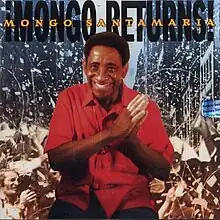| Mongo Returns! | ||||
|---|---|---|---|---|
 | ||||
| Studio album by | ||||
| Released | 1995 | |||
| Genre | Latin jazz | |||
| Label | Milestone[1] | |||
| Producer | Todd Barkan | |||
| Mongo Santamaria chronology | ||||
| ||||
Mongo Returns! is an album by the Cuban musician Mongo Santamaria.[2][3] It was released in 1995.[4] The album marked Santamaria's return to the Fantasy Records label.[5]
Production
The album was produced by Todd Barkan.[6] Its songs were arranged by Marty Sheller.[7] Hilton Ruiz played piano on the album.[8] Eddie Allen played trumpet.[9]
"Bahia" is a cover of the Ary Barroso song; "When Did You Stop Loving Me, When Did I Stop Loving You" is a version of the Marvin Gaye song.[6]
Critical reception
| Review scores | |
|---|---|
| Source | Rating |
| AllMusic | |
| The Encyclopedia of Popular Music | |
| MusicHound World: The Essential Album Guide | |
The Milwaukee Journal Sentinel called the album "marvelous Latin big band" music.[12] The Boston Herald lamented that "the band's performances rarely rise above pleasant and competent."[13] City Pages noted that "rather than wallow in a groove, the tunes on [the] CD continually shift gears, deploying the percussionists as much for texture as for rhythm and varying the pace."[7]
AllMusic wrote that "Mongo's large ensemble sounds sharp, at home with the Latin beat, up-to-date electronic instruments and occasional skipping bassline, and Mongo thunders away with his usual polyrhythmic vigor."[10] The Albuquerque Journal deemed Mongo Returns! one of the best Latin jazz albums of 1995; The Chicago Citizen also listed it among the best of 1995.[14][15]
Track listing
| No. | Title | Length |
|---|---|---|
| 1. | "A Kiss in Her Glance" | |
| 2. | "You've Got It Bad Girl" | |
| 3. | "Bahia" | |
| 4. | "Slyck 'N' Slyde" | |
| 5. | "Song for Marilyn" | |
| 6. | "When Did You Stop Loving Me, When Did I Stop Loving You" | |
| 7. | "Hush" | |
| 8. | "Ol' School Groove" | |
| 9. | "Free World Mambo" |
References
- ↑ "Mongo Santamaría Biography, Songs, & Albums". AllMusic.
- ↑ Birnbaum, Larry (Mar 1996). "Latin jammers". DownBeat. 63 (3): 57.
- ↑ "Obituary: Mongo Santamaria". the Guardian. February 11, 2003.
- ↑ Gerard, Charley (July 23, 2001). "Music from Cuba: Mongo Santamaría, Chocolate Armenteros, and Cuban Musicians in the United States". Greenwood Publishing Group – via Google Books.
- ↑ Lannert, John (Nov 25, 1995). "Latin Notas". Billboard. 107 (47): 63.
- 1 2 3 MusicHound World: The Essential Album Guide. Visible Ink Press. 2000. pp. 688–689.
- 1 2 Robson, Britt (January 31, 1996). "MUSIC". Culture To Go. City Pages.
- ↑ Fernandez, Raul A. (May 23, 2006). "From Afro-Cuban Rhythms to Latin Jazz". University of California Press – via Google Books.
- ↑ Frank, Frederico (4 Apr 1996). "TRUMPETERS TAKE SEPARATE PATHS". News. Milwaukee Journal Sentinel. p. 6.
- 1 2 "Mongo Santamaría - Mongo Returns! Album Reviews, Songs & More | AllMusic" – via www.allmusic.com.
- ↑ Larkin, Colin (2006). The Encyclopedia of Popular Music. Vol. 7. MUZE. p. 251.
- ↑ Spore, Keith (5 Feb 1996). "ABOUT JAZZ". Cue & Health. Milwaukee Journal Sentinel. p. 3.
- ↑ Pekar, Harvey (December 31, 1995). "Afro-Cuban music spices CDs". Arts & Lifestyle. Boston Herald. p. 48.
- ↑ Steinberg, David (7 Jan 1996). "JAZZ ELEVATED TO NEW HEIGHTS, OLD STANDARDS IN '95". Albuquerque Journal. p. D1.
- ↑ Emenari, L.A. (28 Dec 1995). "The Best of Jazz '95". Chicago Citizen. Vol. 30, no. 37. p. 21.